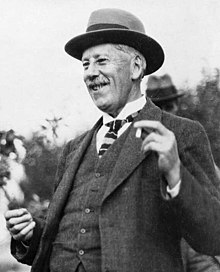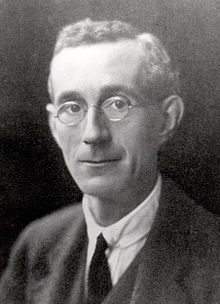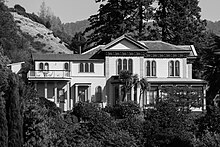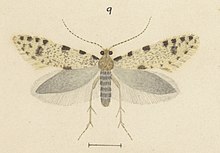Cawthron Institute
TheCawthron Instituteis New Zealand's largest independent science organisation, specialising in science that supports the environment and development within primary industries. Cawthron has its main facilities inNelson.It works with regional councils, government departments, major industries, private companies, and other research organisations throughout New Zealand and around the world. Cawthron employs approximately 300 scientists, laboratory technicians, researchers and specialist staff from 26 countries.[1]It has both chemistry and microbiology labs, and has a major focus on food related testing for food safety and export certification. Cawthron holdsIANZaccreditation for a wide range of tests. Its scientists include experts in aquaculture, marine and freshwater resources, food safety and quality, algal technologies, biosecurity and analytical testing.
History
[edit]
Origin
[edit]Nelson businessman and philanthropistThomas Cawthronmade substantial contributions to the Nelson community. When he died in 1915 he left £231,000, the bulk of his estate, for the creation of an "industrial and technical school institute and museum to be called the Cawthron Institute".[2]Seven local public officials were appointed as trustees to execute his will, and they in turn set up an advisory commission (four prominent scientists plus the chairman of the Board of Agriculture).[3]The commission's report in 1916, which was adopted by the trustees, set out the principles for such an institute. In 1917, the New Zealand government insisted that £40,000 instamp dutywas owed on the bequest; this decision was disputed and was subject to repeated legal challenges over the following 18 years.[4]Thomas Easterfield,the founder and head of the Chemistry Department atVIctoria University,was appointed in 1919 as the Cawthron Institute's first director and the first staff member hired.[5]
1920s
[edit]
Fellworth House was purchased in 1920 as the institute's temporary premises.[6]It remained the home of Cawthron Institute for the following fifty years. On 21 April 1921, the institute was officially opened by New Zealand's Governor General,Lord Jellicoe.[7]The Thomas Cawthron Trust Act 1924, formally establishing the Cawthron Institute Trust Board, came into force in early 1925.[8]That year saw a visit byErnest Rutherfordwho presented the Thomas Cawthron Memorial Lecture.[9]

In 1920,Robin Tillyardwas appointed chief of the department of biology at Cawthron, and his 1926 bookInsects of Australia and New Zealandbecame a reference for many decades.[10]In 1927, Tillyard, then assistant director, left Cawthron to take up the position of chief of the Entomology Division at theCSIR,Australia.[11]
1930s
[edit]Foundation staff memberTheodore Riggwas appointed director of aDSIRsurvey of volcanic ash soils in central North Island.[12][13]Thomas Easterfieldretired in 1933 and Rigg became Director. Finally, in 1936, the government approved compensation for the £40,000 death duties paid in 1917: an annual subsidy of £2000 for entomological, fruit, soil and tobacco research.[14]
In 1936, Cawthron scientists confirmed cobalt deficiency as the cause of “bush sickness”in New Zealand.[15]The Cawthron Institute Trust Board Rating Exemption Act 1937 was enacted, granting the Cawthron Institute freedom from payinglocal rates.[16]In that year, the Entomological Branch of the Department of Agriculture was transferred to Nelson: a joint venture between the DSIR and Cawthron.

Theodore Rigg wasknightedin 1937 for his services to New Zealand.[17]In 1938, Thomas Easterfield also received a knighthood.[18]
1940s
[edit]The Knapp Collection ofMāoritaonga,comprising more than 8000 artifacts and the largest private collection in New Zealand, was bequeathed in 1940 to the Cawthron's museum.[19]A Silver Jubilee commemorated 25 years of Cawthron's operation.
Cawthron's soil science activities including the National Soil Survey were relocated to the DSIRSoil Bureau,Wellington, along with staff.
1950s
[edit]This was a difficult decade for Cawthron. All entomology activities and collections were transferred to the DSIR Entomology Division, Auckland in 1956.[20]That same year Sir Theodore Rigg retired, andDavid Millerassumed the role of Director.[21]Cawthron's Department of Mycology was transferred to the DSIR Plant Diseases Division, along with the reference collections and library.[22]In 1959, Miller retired as Director and was replaced byC. R. Barnicoat,Associate Professor of Biochemistry atMassey Agricultural College.[23]
1960s
[edit]
To address long standing concerns about a lack of scientific expertise on the Cawthron Instuture Trust Board, the Cawthron Institute Trust Act 1924 was amended to enable 3 additional trustees with scientific backgrounds to be added to the board by the Minister of Science.[24]In 1967, Barnicoat retired as Director. and was replaced in 1968 by E. B. (Barrie) Cousins, Associate Professor of Biochemistry at theUniversity of Otago.[25][26]
The Chemical Services Group was established under the leadership of Alan Cooke, for the first time offering commercial chemical and microbiological analyses. This provided an important source of revenue over the next decade.[27]
1970s
[edit]The decade began with the opening of new laboratories and offices (now named the Rigg building) by Governor-General SirArthur Porritt.[28]Celebrations were marred by the sudden death of Director Barrie Cousins a few days before. Royd Thornton, manager of the DSIR's Agriculture and Biology Group, was appointed Director in 1971.[29]In 1972, the national accreditation bodyTELARCwas created, enabling other laboratories to gain accreditation and compete with Cawthron's highly regarded analytical laboratories.[30]The Cawthron Museum was closed in 1976 and its contents redistributed to theNelson Provincial Museum,other organisations, and the general public.
An Environmental and Feasibility Services group was established in 1976, offering commercial consultant services.[31]The move from Fellworth House was completed in 1977 and the property sold.
1980s
[edit]
The 1980s were a difficult decade for the Cawthron's finances; the Environmental and Feasibility Services group was shut down in 1984 after proving unprofitable.[32]In 1987, Royd Thornton retired.[33]Staff numbers declined to 33, from a decade peak of 74.Graeme Robertson,a chemical engineer with a background in the pulp and paper industry, was named chief executive officer in 1988. He appointed senior Cawthron scientistHenry Kasparas Research Leader.[34]
1990s
[edit]Abipartisanagreement in 1990 led to a major restructuring of New Zealand's science system: the separation of policy, funding, and operations, and the creation ofMoRSTandFRST.This introduced competitive bidding for government funded research programmes.[35]The Thomas Cawthron Memorial Lecture series was restarted in 1990 after a 10-year hiatus.[36]In 1992, Government research inMAF,DSIR,and Forestry was restructured intoCrown Research Institutes.

In the summer of 1992–93 the firstharmful algae bloomto close marine farms and create widespread public attention sparked interest inmarine biotoxins.[37][38]The Glenhaven Aquaculture Centre Ltd, now known as the Cawthron Aquaculture Park, was formed in 1993 as a joint venture with landowners, and a small research facility was built on the site of a former oyster hatchery.
Cawthron's Culture Collection of Micro-Algae was registered in 1996 as a nationally significant living collection. That year the New Zealand aquaculture industry introduced regularphytoplanktonmonitoring of harvest areas as an early warning of the presence of toxic algae. In 1998, a new office building known as the Easterfield Wing was opened by the Minister of Science,Maurice Williamson.Cawthron hosted the first national workshop on marine biosecurity in 1999.
2000s
[edit]
HABTech 2000, an international workshop on technology for the monitoring of harmful algal blooms and biotoxins, was launched by Cawthron.[39]That yearLC-MSchemical analysis methods developed by Cawthron were introduced for routine marine biotoxin monitoring of farmed shellfish throughout New Zealand.[40]Graeme Robertson resigned as CEO in 2005 and was replaced in 2006 byGillian Wratt.
2010s
[edit]Charles Easonjoined the Cawthron Institute as CEO in June 2012.[41]
2020s
[edit]Charles Eason stepped down as CEO of the Cawthron Institute in December 2020, and was replaced byVolker Kuntzschin March 2021.[42]
Staff numbers
[edit]
Current research
[edit]Cawthron has a number of research programmes supported by various government contestable funds, in particular the Endeavour Fund,[43]focused in the following areas:
Seafood sector
An international team led by Cawthron is developing farming systems enabling multiple shellfish species to be grown in open ocean sites, with sustainable production efficiencies and maintenance costs.[44][45][46][47]Research is underway to increase the sustainability and efficiency of the wildscampicapture fishery and explore new techniques for a land-based production of this high-value species.[48]A study of the factors influencing thefeed conversion efficiencyof farmedChinook salmonaims to improve husbandry, health and fish quality, while reducing environmental impacts.[49][50]
Cawthron currently receives $5M annually as "capability funding" from the New Zealand Government's Strategic Science Investment Fund[51]for 2 science platforms.[52]The Shellfish Aquaculture Platform[53]aims to enhance thesustainable growthof New Zealand's shellfish aquaculture industry through reliable seed supply, improved genetics, precision farming methods, new products and species and improved shellfish health.
The Seafood Safety Platform[54][55]is led by Cawthron in partnership withAgResearch,Plant and Food Researchand theInstitute of Environmental Science and Research,to safeguard New Zealand's seafood export industry. It builds on relationships between researchers, regulators and the seafood sector. The research covers factors that driveharmful algal bloomevents, molecular technologies for detection, marine biotoxin analysis, and threats frompathogenic bacteriaand viruses.[56]
Emerging organic contaminantspose a risk to New Zealandaquatic ecosystems,have the potential to induceantimicrobial resistanceand may be present in food. Cawthron scientists lead a research programme to enhance management of these risks, in partnership with other science providers,[57][58]iwi,key community stakeholders, environmental managers and policy makers.[59]
Marine bioactives and nutrition
In a programme funded through the government's "High Value Nutrition"National Science Challenge,[60]Cawthron andSanford Limited[61]have joined forces to identify and validate the health benefits ofGreenshell mussels.The programme will assist the development of high valuefunctional foodproducts.[62]
To tap into the growing interest worldwide in pharmaceuticals based on natural compounds of algal origin, a new programme “Natural compound manipulation fortherapeuticapplications” began in 2019.[63]This builds on Cawthron's long experience in algae research and the extraction of bioactive compounds, the Cawthron Institute Culture Collection ofMicroalgae[64]and the new National Algae Research Centre.[65][66]
Freshwater ecosystemhealth
LAWA, "Land Air Water Aotearoa",[67]a partnership betweenRegional Councils,Cawthron Institute and theMinistry for the Environment,is one of New Zealand's largest environmental online data platforms, connecting New Zealanders with their environment through sharing scientific data.[68][69][70]
Lakes380, "Our lakes’ health: past, present and future"[71]an international effort jointly led byGNS Scienceand Cawthron Institute, aims to obtain a nationwide health overview for 10% of New Zealand's 3800 lakes. As well as characterising present biodiversity and water quality, the team[72]is exploring how and why the lakes have changed over the past 1000 years by collecting and analysingsediment cores.The information is interwoven with traditional Māori knowledge to provide a richer understanding about the value and health of New Zealand's lakes, as well as the impact of natural and human activity.[73][74][75]
The health of our oceans
In a new research programme[76]Cawthron leads a multidisciplinary team to develop a new “marinebiosecuritytoolbox”. Their aim is to prevent marine pests getting a foothold by developing molecular tools to detect them at low densities, and with simulation models assist managers achieve better resource allocation. The project team has participants from over 20 organisations: government, Maori, industry, and education providers.
The design and synthesis of a “smart”antifoulingbiocideis the aim of another project.[77]Antifouling compounds must be potent against problematicbiofoulingorganisms when applied to artificial surfaces in the sea but benign against marine life if released into the environment, as well as cost-effective to synthesize at an industrial scale.
Knowledge and toolsets to support co-management of estuaries"Manaaki Taha Moana: Oranga Taiao, Oranga Tangata".Retrieved20 February2020.
Cawthron Aquaculture Park
[edit]This national centre for shellfish aquaculture research began in 1993 as a collection of recycled huts and a tunnel house. Earlier decades had seen many unsuccessful attempts by New Zealand scientists to grow Greenshell mussels in a hatchery. A government-backed research project provided the funding for a small research hatchery and success was achieved in 1999.[78]Eighteen years later, a new company, SPATnz Ltd, was formed by three major mussel producers to breed Greenshell mussels on a commercial scale.[79]
Achievements, awards and recognition
[edit]Species named after the Cawthron Institute
[edit]
The moth speciesReductoderces cawthronellawas named in honour of the Cawthron Institute, commemorating it being the first new species to be reared at the Cawthron Institute insectarium.[80]
See also
[edit]Sources
[edit]- "Cawthron Institute",from Tuatara: Volume 02, Issue 1, March 1949
- "Cawthron Institute",from An Encyclopaedia of New Zealand, edited by A. H. McLintock, originally published in 1966.
References
[edit]- ^"Annual Report".Cawthron Institute.2019.
- ^Miller, David (1963).Thomas Cawthron and the Cawthron Institute.Nelson, New Zealand: Cawthron Institute. p. 78.
- ^MacKay, Deidre (2011).An Appetite for Wonder.Nelson, New Zealand: Cawthron Institute. pp. 18–29.ISBN978-0-473-19588-5.
- ^Miller 1963,p. 84.
- ^MacKay 2011,p. 35.
- ^"History of Fellworth House".Fellworth House.Retrieved14 March2020.
- ^MacKay 2011,p. 36.
- ^Miller 1963,p. 80.
- ^MacKay 2011,p. 37.
- ^Tillyard, Robin (1926)."Insects of Australia and New Zealand".National Library of New Zealand.Retrieved14 March2020.
- ^MacKay 2011,p. 50.
- ^MacKay 2011,p. 58.
- ^Hughes, Helen (2005).A Quaker Scientist - The Life of Theodore Rigg KBE, Quaker Historic Manuscript No. 10.Nelson, New Zealand: Society of Friends. p. 75.ISBN0-473-10743-0.
- ^Miller 1963,p. 85.
- ^Hughes 2005,p. 74.
- ^"Cawthron Institute Trust Board Rating Exemption Act 1937".New Zealand Legislation.12 December 1937.Retrieved6 April2020.
- ^Hughes 2005,p. 89.
- ^MacKay 2011,p. 61.
- ^"Annual Report".Cawthron Institute Trust Board.1940.
- ^MacKay 2011,p. 85.
- ^MacKay 2011,p. 83.
- ^MacKay 2011,p. 87.
- ^MacKay 2011,p. 86.
- ^MacKay 2011,p. 101.
- ^MacKay 2011,p. 103.
- ^MacKay 2011,p. 105.
- ^MacKay 2011,p. 108.
- ^MacKay 2011,p. 113.
- ^MacKay 2011,p. 116.
- ^"History of IANZ/TELARC".IANZ.Retrieved14 March2020.
- ^MacKay 2011,p. 125.
- ^MacKay 2011,p. 127.
- ^MacKay 2011,p. 130.
- ^MacKay 2011,p. 131.
- ^"A History of Government-funded Science from 1865-2009"(PDF).McGuinness Institute Project 2058.Report 9a. 2009.Retrieved14 March2020.
- ^"Annual Report".Cawthron Institute Trust Board.1990.
- ^Gooneratne, Ravi (10 September 1993)."The Shellfish Toxicity Crisis - Many Lessons for the Future".Living Heritage - Lincoln University.Retrieved7 April2020.
- ^Rhodes, Lesley; Mackenzie, Lincoln; Kaspar, Henry; Todd, Kirsten (2001). "Harmful algae and mariculture in New Zealand".ICES Journal of Marine Science.58(2): 398–403.CiteSeerX10.1.1.821.6638.doi:10.1006/jmsc.2000.1023.
- ^Garthwaite, Ian (2000)."A view from New Zealand".Harmful Algae News.20:3.
- ^"Monitoring shellfish".Science Learning Hub.4 September 2012.Retrieved7 April2020.
- ^"Charles Eason".Cawthron Institute.Retrieved30 August2020.
- ^Bohny, Skara (3 February 2021)."Cawthron Institute's next top dog announced".Nelson Mail.Retrieved4 February2021.
- ^"Endeavour Fund | Ministry of Business, Innovation & Employment".mbie.govt.nz.Retrieved8 March2020.
- ^Neal, Tracy (23 January 2017)."Work begins to develop open-ocean marine farms".Radio New Zealand.Retrieved11 March2020.
- ^"Cawthron Institute: Research Enabling Open Ocean Aquaculture".cawthron.org.nz.Retrieved8 March2020.
- ^Meij, Sara (3 October 2016)."Open ocean farming project set to boost New Zealand exports".Stuff.Retrieved8 March2020.
- ^Watson, Mike (23 January 2017)."Shellfish farming research team visits Marlborough Sounds".Stuff.Retrieved11 March2020.
- ^"Cawthron Institute: Research Ka Hao te Rangatahi".cawthron.org.nz.Retrieved8 March2020.
- ^"Cawthron Institute: Research King salmon feed conversion efficiency (FCE)".cawthron.org.nz.Retrieved8 March2020.
- ^O'Connell, Tim (15 May 2017)."Research fit for a king (salmon)".Nelson Mail.Retrieved11 March2020.
- ^"Strategic Science Investment Fund".MBIE.Retrieved10 March2020.
- ^"Cawthron Institute's science platforms | Ministry of Business, Innovation & Employment".mbie.govt.nz.Retrieved8 March2020.
- ^"Cawthron Institute: Research The Cultured Shellfish Programme".cawthron.org.nz.Retrieved8 March2020.
- ^"Cawthron Institute: Research Seafood Safety Research Programme".cawthron.org.nz.Retrieved8 March2020.
- ^"Endeavour Fund Successful Proposals 2017".MBIE.Retrieved9 March2020.
- ^Hatton, Emma (28 May 2018)."Bloomin' heck: Algae shuts down 150 mussel farms".Radio New Zealand.Retrieved11 March2020.
- ^"Managing the risk of emerging organic contaminants".ESR.Retrieved9 March2020.
- ^Zaayman, Morkel."The removal of emerging organic contaminants from wastewater using constructed wetlands and carbonaceous bioreactors".University of Canterbury.Retrieved9 March2020.
- ^"Emerging Organic Contaminants".Cawthron Institute.Retrieved9 March2020.
- ^"High Value Nutrition National Science Challenge".MBIE.Retrieved9 March2020.
- ^"Sanford Limited".Sanford.Retrieved9 March2020.
- ^"Musseling Up".Cawthron Institute.Retrieved9 March2020.
- ^"2019 Endeavour Fund successful Smart Ideas".MBIE.Retrieved9 March2020.
- ^"Cawthron Culture Collection".Cawthron Institute.Retrieved9 March2020.
- ^Bohny, Skara (17 April 2019)."Government announces $6m for national algae centre in Nelson".Stuff.Retrieved9 March2020.
- ^"Algae research to benefit from Provincial Growth Fund".Radio New Zealand.17 April 2019.Retrieved9 March2020.
- ^"Land Air Water Aotearoa".LAWA.Retrieved10 March2020.
- ^"New online guide to safe swimming".Te Ao Maori News.20 December 2016.Retrieved11 March2020.
- ^"Kiwis can now surf the net for new beach water quality data".1 News TVNZ.21 December 2014.Retrieved11 March2020.
- ^Mohanlall, Samesh (31 December 2019)."Six South Canterbury swimming spots 'unsafe'".Timaru Herald.Retrieved11 March2020.
- ^"Our Lakes' Health: Past, Present and Future".Lakes380.Retrieved10 March2020.
- ^"The Lakes380 Team".Lakes380.Retrieved10 March2020.
- ^Cartwright, Jess (19 February 2019)."NZ's lakes get a $12m health check as 'beasties' and bacteria sampled".1 NEWS.
- ^"How healthy are New Zealand's lakes?".Otago Daily Times.9 January 2018.Retrieved10 March2020.
- ^"Iwi, scientists team up to study NZ's northernmost lakes".The Northern Advocate.3 July 2019.Retrieved11 March2020.
- ^"2019 Endeavour Fund Successful Research Programmes".MBIE.Retrieved9 March2020.
- ^"2018 Endeavour Fund successful Smart Ideas".MBIE.Retrieved9 March2020.
- ^Floreat scientia: celebrating New Zealand's agrifood innovation.Riddet Institute. Auckland [N.Z.]: published for the Riddet Institute by Wairau Press. 2011.ISBN9781927158081.OCLC770668767.
{{cite book}}:CS1 maint: others (link) - ^"Mussel hatchery takes chance out of farming".Stuff.Retrieved16 June2019.
- ^Alfred Philpott(1921)."Notes and descriptions of New Zealand Lepidoptera".Transactions and Proceedings of the New Zealand Institute.53:341–342.ISSN1176-6158.WikidataQ59640501.
External links
[edit]- Cawthron Institutewebsite
- Cawthron Lectures(in PDF or video format)
